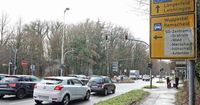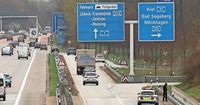Across several regions in Germany, drivers are facing significant slowdowns due to new construction projects and accidents, with traffic congestion reported on major highways and federal roads. From Celle to Lübeck, and from Remscheid to Solingen and Gifhorn, the latest updates reveal a complex web of delays that commuters need to navigate carefully.
In Celle and its surrounding areas, traffic jams have become a common sight, particularly on critical routes such as the Bundesstraßen B3, B191, and B214. The Wilhelm-Heinichen-Ring in Celle is also under construction, prompting authorities to advise motorists to take wider detours. These slowdowns are not isolated; they ripple through the region, affecting travel times and daily routines.
Similarly, in Lübeck and the northern parts of Schleswig-Holstein, congestion is frequently reported on autobahns A1, A20, and A226, as well as on federal highways B75, B207, and B104. The A1, a vital artery connecting Hamburg to coastal towns through Stormarn and Ostholstein to Fehmarn, experiences heavy traffic, especially during tourist peak times. The ADAC (German Automobile Club) highlights the A1 and A7 as particularly prone to bottlenecks in the region.
Further west, the metropolitan areas around Remscheid, Solingen, and Wuppertal are grappling with some of the most congested roads in North Rhine-Westphalia (NRW). Autobahns A1 and A46 are notorious for their traffic jams, ranking among the top six most congested routes in NRW in 2023. The A1 stretch between Cologne and Dortmund alone accounted for nearly 6,500 hours of delays last year. The A46, linking Düsseldorf and Wuppertal, holds the sixth spot in congestion rankings and is crucial for commuters heading to the state capital and the Ruhr area.
In Solingen, the A3 stands out as the most congested autobahn in NRW, with over 10,000 hours of traffic jams recorded between Cologne and Oberhausen in 2023. This stretch includes the segment between Kreuz Leverkusen and Kreuz Hilden, which is vital for local commuters. Currently, ongoing construction at the A3-Solingen interchange, involving closures and detours, is exacerbating traffic woes. The A1 and A46 also remain significant sources of delay for Solingen residents.
Federal highways and state roads in these regions are equally affected. In Remscheid, the B229 runs through the city and connects to Radevormwald and Solingen, serving as a key east-west corridor. The B237 links Wipperfürth to Bergisch Born, passing through important commuter zones like the Eichholz industrial park. The B51 and its newer variant B51n traverse the region from the A1 exit at Burscheid to Remscheid’s Trecknase intersection. State roads such as the L74 (Kohlfurth) and L101 in Wermelskirchen and Burscheid also experience frequent congestion, especially near autobahn on- and off-ramps.
Solingen’s local roads are no less impacted. Apart from the major autobahns, streets like the B229 and B224, connecting to neighboring cities and autobahns, face heavy traffic. The L357 Roggenkamp serves as a vital connector to the A46, while the Viehbachtalstraße, often referred to as the 'Stadtautobahn,' handles significant commuter flow. Other important thoroughfares include Cronenberger Straße, Katternberger Straße, Bonner Straße, and several others that weave through the city, bearing the brunt of daily traffic.
In Gifhorn, a similar pattern emerges. The region’s traffic snarls involve the autobahns A2 and A39, alongside federal highways B188, B4, B214, B248, and the district road K114. Construction sites and accidents contribute to slower traffic, impacting both local and through traffic.
What ties these diverse regions together is the source and management of traffic data. All updates come from TomTom, a leading navigation system provider that aggregates GPS coordinates from millions of devices, automatic data from roughly 80 million mobile devices, millions of official road sensors, and manually curated information. This comprehensive data pool ensures accurate and timely reporting, with updates refreshed every five minutes. Other navigation platforms such as Google Maps, Apple Maps, and Garmin also provide traffic information but are not the primary sources for these regional reports.
Authorities and traffic experts consistently urge drivers to show patience and consideration. "Please always take care and be considerate of other road users," is a recurring advisory across all regions. This reminder underscores the human element amid the technical data—recognizing that behind every slowdown is a community of commuters striving to reach their destinations safely.
Looking ahead, major infrastructure projects are expected to shape traffic patterns for years to come. The ongoing reconstruction of the Wuppertal-Nord motorway interchange, a mammoth undertaking planned for the next decade, will have significant implications for the A1 and A46 corridors. Similarly, prolonged construction at critical junctions like the A3-Solingen interchange will continue to challenge drivers and planners alike.
As Germany’s road networks evolve, balancing necessary upgrades with the daily realities of traffic remains a delicate act. For now, travelers in Celle, Lübeck, Remscheid, Solingen, Gifhorn, and beyond must navigate a patchwork of delays and detours, armed with up-to-the-minute information and a spirit of mutual respect on the roads.





